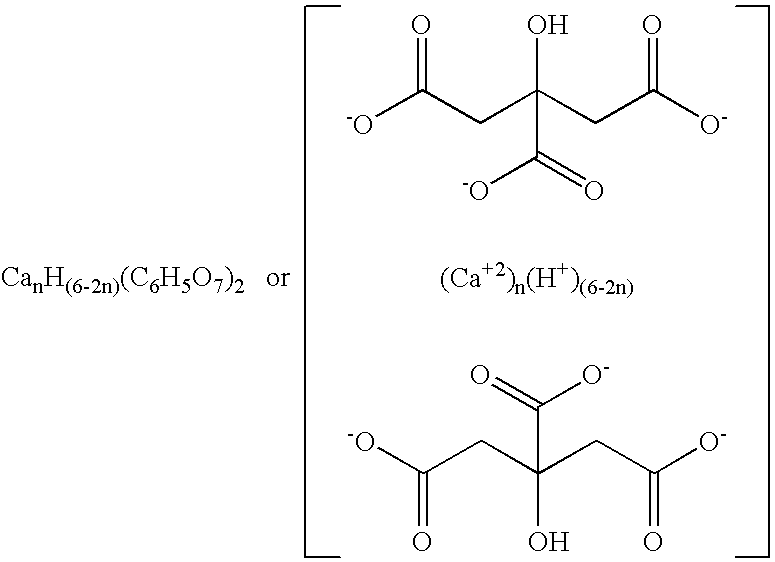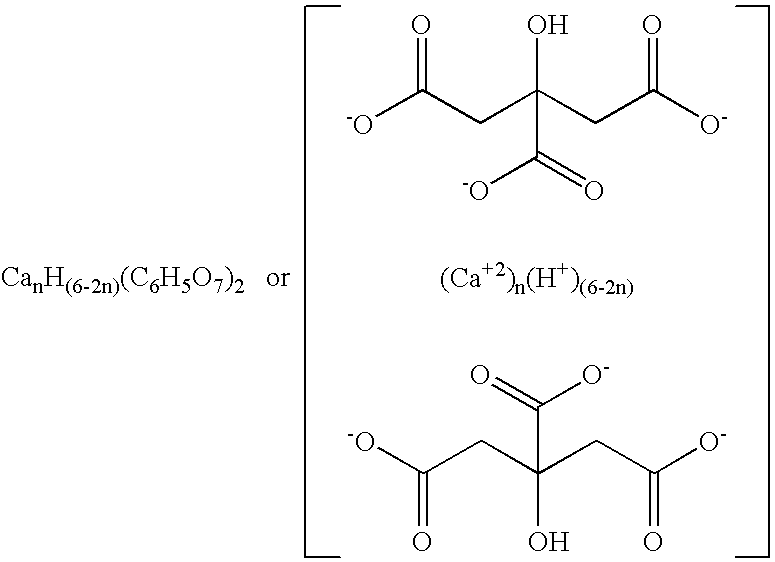Amorphous water-soluble calcium citrate salts and method of making and using same
a technology of amorphous water-soluble calcium citrate salt, which is applied in the direction of drug composition, grain treatment, metabolic disorder, etc., can solve the problems of increasing the risk of osteoporosis later in life, many conventional dietary sources of calcium contain less than desired levels of calcium, and achieve enhanced stability and bioavailability, high calcium levels, and enhanced solubility
- Summary
- Abstract
- Description
- Claims
- Application Information
AI Technical Summary
Benefits of technology
Problems solved by technology
Method used
Image
Examples
example 1
[0048] A series of calcium citrate salts was produced according to the embodiments of the invention for the purpose of identifying a practical upper limit of calcium:citrate mole ratio that can be easily produced in amorphous form while preventing significant solidification, crystallization, or sedimentation of the reaction mixture prior to drying. Powders having calcium:citrate mole ratios of 1:2 (monocalcium citrate or MCC), 1.5:2 (sesqui-calcium citrate or SCC), 2:2 (dicalcium citrate or DCC), 2.25:2, 2.4:2, 2.5:2, and 3:2 (tricalcium citrate or TCC), respectively, were separately produced by quickly pouring room temperature (about 22° C.) calcium hydroxide suspensions (7.4 to 22.2 g in 100 g water) into room temperature citric acid solutions (38.4 g in 100 g water), stirring vigorously for several seconds or until the hydroxide completely dissolved to form clear yellow-green solutions, quickly pouring the solutions into trays, immediately freezing via direct addition of liquid n...
example 2
[0058] As an alternative to freeze drying, an amorphous 2:2 mole ratio calcium citrate salt, using the same ingredients as in Example 1, was also successfully produced via spray drying (i.e., pilot scale drying using standard operating conditions and procedures). In this case, chilled calcium hydroxide and citric acid solutions were combined and rapidly spray dried before solidification or sediment formation could occur. Addition of 240 ml room temperature water to 2 g of this fine white powder produced an instantly dissolving clear solution, providing 350 mg calcium per eight ounce serving, that remained completely free of sediment for at least three days at room temperature. In a large scale commercial process, the citric acid and calcium hydroxide (or other suitable reagents) would be beneficially combined just prior to spray drying to limit the potential for solidification or sediment formation.
[0059] Based on the successful production of an amorphous 2:2 mole ratio calcium cit...
example 3
[0061] This example illustrates the preparation of an amorphous salt having calcium:citrate mole ratio of 1:2 and which contains nutritive levels of iron, potassium, and calcium. Iron sulfate heptahydrate (0.54 g), potassium hydroxide (10.20 g), and citric acid (18.46 g) were sequentially dissolved in 100 g water. Calcium hydroxide 3.70 g was slurried in 100 g water and poured into the solution containing citric acid at room temperature (about 22° C. The resulting solution had a light yellow color and was clear and sediment free. The solution was poured into a tray, rapidly frozen by direct addition of liquid nitrogen, and then freeze dried.
[0062] The dried granular salt had a light yellow color and was easily ground to a fine powder using mortar and pestle. The powder (1.4 g) dissolved instantly and completely in eight fluid ounces of cold water to provide a liquid composition containing FDA good-source levels of iron (about 5 mg), calcium (about 100 mg), and potassium (about 350 ...
PUM
| Property | Measurement | Unit |
|---|---|---|
| temperatures | aaaaa | aaaaa |
| temperature | aaaaa | aaaaa |
| mole ratio | aaaaa | aaaaa |
Abstract
Description
Claims
Application Information
 Login to View More
Login to View More - R&D
- Intellectual Property
- Life Sciences
- Materials
- Tech Scout
- Unparalleled Data Quality
- Higher Quality Content
- 60% Fewer Hallucinations
Browse by: Latest US Patents, China's latest patents, Technical Efficacy Thesaurus, Application Domain, Technology Topic, Popular Technical Reports.
© 2025 PatSnap. All rights reserved.Legal|Privacy policy|Modern Slavery Act Transparency Statement|Sitemap|About US| Contact US: help@patsnap.com


